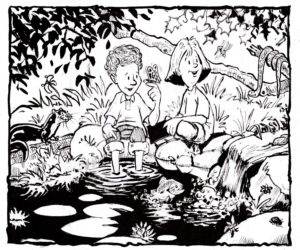Local Water is Global Water

To view the photo-rich magazine version, click here.
Originally appears in the Fall 2018 issue.
ACCORDING TO United Nations Global Issues reports, about 2.1 billion people around the world don’t have access to safely managed drinking water. That’s more than a quarter of the world’s population! For many students who are living in developed countries such as the United States, Canada, and Australia where there is an abundance of water resources in most regions, statistics like that are hard to imagine. How can teachers help students aged seven to twelve conceptualize and approach a problem so vast and seemingly unapproachable?
The answer can be found close to home. Scientists have long known that local ecosystems affect local water quality. If an ecosystem is polluted, the water there will be too. And water doesn’t stay in one place — it travels the globe in various forms. Therefore, we all have an obligation to take care of the water in our own homes and neighborhoods so as to contribute to the general well-being of the world’s water supply. In other words, the health of water worldwide is connected to the health of the pond down the road from your school. A logical step, then, is for students to become better acquainted with the waterways around them, including the plants and animals that live in them and depend on that water for survival. This follows a paradigm guided by the question, “What’s happening in my own backyard, and what can I do to help?” This paradigm is known as the “ecosystem approach,” or “biodiversity for wellbeing,” and teaching it to our kids could have huge implications for the future.
The ecosystem approach was defined in 1993 in the Convention on Biological Diversity, a multilateral treaty signed by 196 parties that promotes the protection of the biodiversity of the planet. While the ecosystem approach of considering the entire picture when implementing conservation efforts has long been practiced by some groups around the world, this formal treaty recognizes biodiversity as a common concern and shared responsibility, and offers specific protocols meant to protect the planet. For kids, though, this approach is a wonderful way to learn about the interconnectivity among all environments.
This content is restricted to subscribers only.
If you are not yet a subscriber, please consider taking out a subscription here.
If you are an existing subscriber, kindly log in or contact us at info@greenteacher.com for more information.





